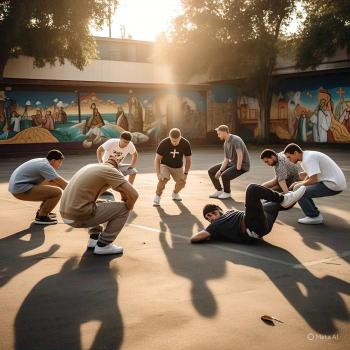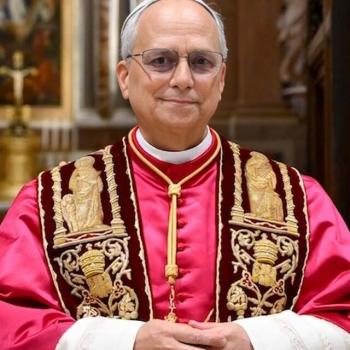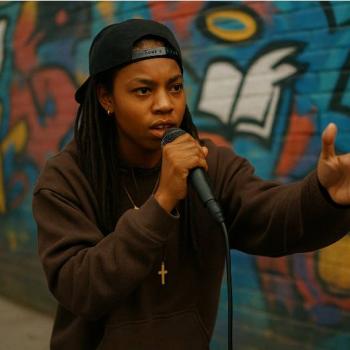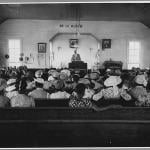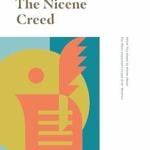Theomusicology is the musicological study of religious music, including orthodox religious music study, history, and analysis, hymnology study, history, and analysis, and the composition of gospel music. The discipline was set in motion by the dedication of the critical musicologist Jon Michael Spencer. Binding gospel study, analysis, and the application in orthodox, contemporary, revival, and reformist liturgical settings, Jon Michael Spenser addresses how music is used to express gospel truth, its absorption by church audiences, and how pop culture expressions are used in this subgenre. It is this collected work that lays the claim to the title of this musicological subgenre, “theomusicology” (theo – religious study; muscology – study of a particular style/genre of music). Originally contextualized in orthodox religious circles, Jon Michel Spenser’s work has expanded to include how soul, R & B, Funk, and the early developments of Hip Hop relate to and express church expressions as agency for pop culture signifiers. Jon Michael Spenser’s work lends itself to the construction and foundation of the four core elements of Christian Hip Hop: testimony, evangelism, discipleship, and biblically-centered lyrics.
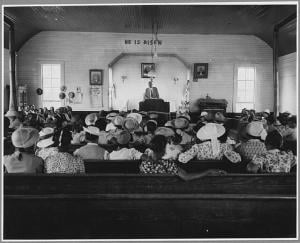
June 19, 2025, is the observance of Juneteenth, the most recent federal holiday in America’s history. A well-written article by Professor Timothy Wellbeck, Director of the Center for Anti-Racism, Temple University, in The Conversation (June 19) provides the background and importance of this federal day of observation.
Juneteenth – short for June Nineteenth – recognizes the day in 1865 when Maj. Gen. Gordon Granger arrived in Galveston, Texas, with roughly 2,000 federal troops from the 13th Army Corps. Upon arriving, Granger issued General Order No. 3. The order read:
“The people of Texas are informed that, in accordance with a proclamation from the Executive of the United States, all slaves are free. This involves an absolute equality of personal rights and rights of property between former masters and slaves, and the connection heretofore existing between them becomes that between employer and hired labor. The freedmen are advised to remain quietly at their present homes and work for wages. They are informed that they will not be allowed to collect at military posts and that they will not be supported in idleness either there or elsewhere.”
Granger’s order effectively freed 250,000 enslaved people in the region.
Though President Abraham Lincoln issued the Emancipation Proclamation, which freed the enslaved in all the states that had seceded from the U.S., nearly 2½ years earlier, Texas, a Confederate state, rebelled against it.
At the time, Texas had a minimal number of Union soldiers to enforce the proclamation’s emancipation of enslaved people residing within Confederate territory. Consequently, many of those enslaved in Texas remained ignorant of the proclamation’s potential impact on their lives, or of the fact the Civil War had functionally ended two months earlier. (Timothy Wellbeck, The Conversation, June 19).
The importance of this day, Juneteenth, lends itself to a review of theomusicology in relationship to Christian Hip Hop discourse. A dual tip-of-the-hat to the scholar Jon Michael Spenser, and recognizing the importance of Juneteenth.
Theomusicology as Discourse
Prager (1991) helps define the discipline and discourse of theomusicology.
“Theomusicology is musicology as a theologically informed discipline. Borrowing thought and method from anthropology, sociology, psychology, and philosophy, it has as its subject the myriad cultural worlds of ethical, religious, and mythological belief. Theomusicological research into cultural/intercultural reflections on the ethical, the religious, and the mythological involves the study of music in the domain or communities of the sacred, the secular, and the profane. By examining the depths of sacrality, secularity, and profanity in the music of civilization’s many cultures, the theomusicologist can increasingly discern how particular peoples perceive the universal mysteries that circumscribe their mortal existence, and how the ethics, theologies, and mythologies to which they subscribe shape their worlds.” (Prager, PhiliPapers, 1991).
This helps better understand how Christian Hip Hop can be viewed as a subdiscipline of theomusicology. Though Jon Michael Spencer frames his initial work around the Black Church, and how music and theological discourse are connected to elevate and discern a connection between spirituality and music, Christian Hip Hop borrows the trajectory and foundation of Jon Michael Spencer’s work and narrates it along the lines of the four elements of Christian Hip Hop (testimony, discipleship, evangelism, biblically-centered lyrics) and the core foundations of Hip Hop culture (rap/MC, DJ, graffiti, breakdance, fashion, literature). It is the “message” in each of these genres which are different, yet unified in an overarching critique. Christian Hip Hop uses the message of the gospel to convey and create disciples, following the Great Commission (Matthew 28: 18-20; Acts 1:8; Mark 16:15; John 20:21). Hip Hop holds the message of resistance against socio-political, economic, and educational oppression. The unification of these genres is at the core of the messages: support, share, and serve the community, provide a firm foundation for assistance and positive identity in the community, have faith in your calling to better the community and by proxy yourself, and witness to others in your community. Though not stated as such, the unification is transparent yet visible.
In the later portion of his book, “Theological Music: Introduction to Theomusicology,” Jon Michel Spencer
“illustrates how theomusicology can, and at its best does, involve dialogue with different disciplines as well as a gamut of historical epochs and movements…Spencer’s work establishes theomusicology as a scholarly discipline and a valid research approach to studying world religious, mythological, and ethical beliefs via music.” (Prager, PhiliPapers, 1991).
Following this discursive practice, Christian Hip Hop is within the field of theomusicology. The foundations and scope of theomusicoology, from the man who established the discipline, Jon Michael Spencer, it is clear that Christian Hip Hop is within this critical musicological discourse, theomusicoology.
Soul Redemption
Looking back at the original work of Jon Michael Spencer, I offer a theomusicological reading of two giants of soul music, James Brown and Aretha Franklin. At the conclusion, I contextualize how soul and Christian Hip Hop are more connected than a primary reading would suspect. Using a theomusicological reading of James Brown and Aretha Franklin, I argue for their importance to the field of theomusicology and how they articulate the four core elements of Christian Hip Hop.
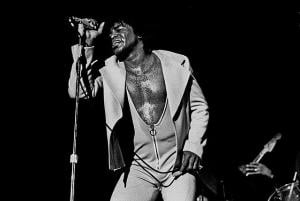
“It’s A Man’s Man’s Man’s World” (Official Live Performance Video),
Coined the “Godfather of Soul,” James Brown nearly single-handedly built the genre. His glossy melismatic lines, preacher-style wails, and timely placed grunts, James Brown allowed his lyrics to drive the musical landscape along with the accompaniment. At times, James Brown’s voice could be as thumping as the drummer’s snare, as riveting as a guitarist’s solo, and as slappy as a funk keyboardist’s style. The beauty of James Brown is that each of these musical vocabularies is intertwined and could be heard in a single track. The preacher-esque quality of James Brown’s approach crossed secular and sacred musical borders. When used, backing choirs reference the Black Church choirs, allowing James Brown freedom to “call” across space and be freed lyrically, with the accompaniment maintaining a steady groove, supporting his growling melismas.

In the provided example, “It’s A Man’s Man’s Man’s World,” James Brown illustrates a variety of preacher tones and styles. The opening quality is the calm, patient preacher who unfolds scripture to the congregation. At times singing, then conversing, James Brown maneuvers the text easily and delicately, paying attention to the message and meaning. As the work moves toward the middle, James Brown elevates the tension. Starting slow, with pointed, distorted vocal gestures, the text becomes alive, and the meaning is amplified. The closing needs only to restate the message, “This is a man’s world,” with a clear yet biting tone. James Brown walks the listener through three different preacher styles: patient with conviction, pointed with a driving message, and a hyper-compressed revelation of the message. An audience favorite soul ballad, which has graced the ears of multiple generations, James Brown continued to speak across the divisions of sacred and secular music without leaving his trademark preacher-style lexicon.
“Oh, Mary, Don’t You Weep” is classified as a slave song. The intent of the song is the coding in the use of the name “Mary” to mean liberation, freedom, and solace in God’s promise of liberation for His people.
“The Black church standard, “O Mary Don’t You Weep,” undoubtedly began before the Civil War as a “slave song.” It would have been sung without instruments, possibly at secret church gatherings at a time when Southern slave owners were trying to control Christianity among Blacks. They wanted to emphasize only those Biblical passages that pushed obedience. And in the tales it cites, “Mary” has a coded message against oppression, a longing for justice.” (Jerome Weeks, Art and Seek, February 2021).
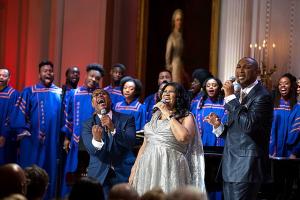
In his historic reading of the track, Weeks notes the “call” that preachers, in the Black Church, would make throughout their sermons, which drew emotional passion from the congregation to the gospel message. The “call” can be read in Christian Hip Hop as both the testimony and discipleship. In Hip Hop culture, this is recognized as the “message” which MCs use to heighten their raps. Both forms of Hip Hop align with this point, the “call,” placing a firm foundation in the Black Church and the following Gospel Music tradition. It is the freedom of expression and artistic style that distinguishes the “call” from one artist to another.
Weeks provides the biblical references of the song, which underscores the value of the work in gospel music and Christian Hip Hop discourse.
“[T]he song essentially derives from three Biblical stories: the sisters Mary and Martha being consoled by Jesus because he’s raised their brother Lazarus from the dead; the flight from Egypt with Moses causing the Red Sea to destroy Pharaoh’s army and – not in all versions – God’s promise to Noah after the Flood…The three stories are completely unrelated in the Bible, but as lyrics, they overlap to great emotional effect, particularly for an enslaved or downtrodden congregation. They provide advice (don’t despair), hope for the future (God will help), and a promise of justice (“the fire next time”) (Jerome Weeks, Art and Seek, February 2021).
The patience that Aretha Franklin exudes is remarkable. Playing in the spaces in between the hypnotic, undulating musical accompaniment, the choir articulates her points. In this example, Aretha Franklin is the quintessential preacher. She floats the lyrics across time, leaving the audience in anticipation of her next expression. As the track continues, the pulse of the band drives, and Aretha Franklin pushes back. Short repeated phrases are placed perfectly in a higher pitch and tone, each being supported by the choir. When the wails and melisma, and syllabic singing enter, Aretha Franklin embodies the persona of preacher par excellence. The 1972 live recording at the New Temple Missionary Baptist Church in Los Angeles, with the Reverend James Cleveland and the Southern California Community Choir, earned Aretha Franklin a Grammy Award for Best Soul Gospel Performance (1973). Over 50 years since the initial release, the recording remains one of the highest-grossing gospel recordings. This is a testimony to the power of gospel music, the artistic brilliance of Aretha Franklin, and the power of scripture-centered music.
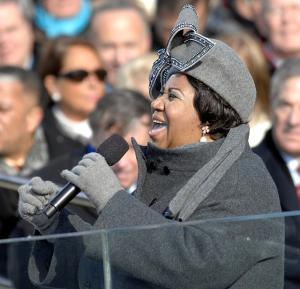
Gospel And Soul In Christian Hip Hop
The four core elements of Christian Hip Hop are demonstrated in these two gospel, soul music examples. James Brown denotes evangelism and testimony by way of his selection of songs. Aretha Franklin incorporates discipleship and scripture-centered lyrics. The unfolding genre of Christian Hip Hop has a strong tie to gospel and soul music. Coming through the Black Church, the four core elements of Christian Hip Hop articulate the complex history of the Black Church and its musical legacy. Funk and disco have ties to Hip Hop, whereas gospel and soul have ties to Christian Hip Hop. The dynamic fluidity of Christian Hip Hop involves sacred and secular musical and cultural signifiers, positioning this genre at the core of theomusicology. Jon Michael Spencer’s critical work in developing the field of theomusicology holds a strong grip on Christian Hip Hop. When applying a critical theomusicological reading, it becomes quite clear which artists and works claiming to be “authentic” Christian rap, Christian Hip Hop, or Gospel rap can be viewed in this discourse. Theomusicology opens multiple doors to read culture, sound, biblical knowledge, and socio-religious signifiers. The term may appear daunting, but the field is broadly welcoming.




